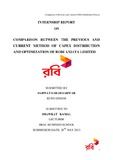Comparison between the previous and current method of copex distribution and optimization of Robi Axiata Limited

View/
Date
2013-05-28Publisher
BRAC UniversityAuthor
Sarah Sarwar, SarwatMetadata
Show full item recordAbstract
RobiAxiata Limited is the third largest telecommunication service provider in
Bangladesh and, over time, it is steadily increasing its customer base and number
of subscribers. In order to do so, Robi has to constantly increase its investment
prospects to get an ideal return on invested capital. The decision to invest and
which areas would provide the greatest return and least risk is crucial and must be
made with care. So, Robi has to constantly analyze its potential and in which
investment areas it is wise to deploy its Capital Expenditures (CAPEX)
Previously, the system of CAPEX distribution lay solely in the control of the
Market Operations and Technology. Market Operations would routinely send
monthly demand forecast to the Technology division. The Technology department
would then assess the areas where new technology is required or a new BTS
implementation is required to send a budget requirement form to the Integrated
Planning department of the Finance division. The finance division would then send
the required CAPEX. The CAPEX deployed to these areas would be done without
any intervention from the Finance department and there would be no financial
calculations conducted, such as calculating the Net Present Value (NPV) or the
Internal Rate of Return (IRR) of these investment prospects. Thus, there was no
way to calculate the required rate of return (RRR) of these projects and whether
they will generate a net profit anytime soon. As a result, it was seen that, despite
the large amounts of CAPEX deployed in these areas, there weren’t any profits
being accumulated and the CAPEX was being tied down in loss generating
investments.
